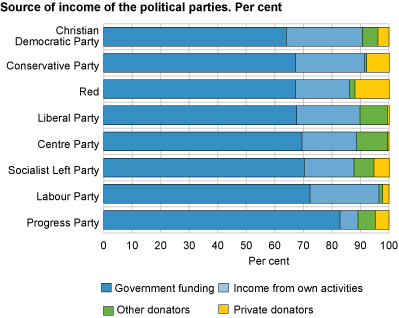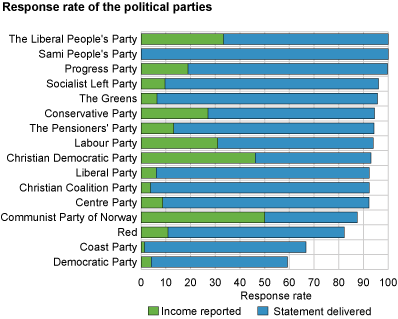Content
Published:
This is an archived release.
Three quarters from government funding
Government funding accounted for 74 per cent of political parties' income in 2010 - an intermediate election year - which is about the same share as in the previous intermediate years between elections 2006 and 2008. The proportion accounted for the least part of the Christian Democratic Party and the Conservative’s funding, and the highest for the Progress Party.
Nearly 80 per cent of the party organisations reported that - excluding government funding - they had an income of below NOK 10 000. The remaining 20 per cent, in total 654 party organisations, reported having an income of at least NOK 10 000 each. They reported having received NOK 515 million in total, of which government funding accounted for NOK 383 million, while income from own activities accounted for about NOK 100 million. Among the political parties with representation at the Storting, a total of 46 per cent of the organisations of the Christian Democratic Party and 31 per cent of the Labour Party reported having an income of more than NOK 10 000, whereas only 6 and 9 per cent respectively of the organisations of the Liberal Party and Centre Party reported likewise.
NOK 200 million in governmental funding to the Labour Party and the Progress Party
The governmental funding was mainly given as political party subsidies from the central government. For municipality and county organisations, the party subsidies in 2010 were calculated by using the results of the local elections in 2007. Correspondingly, the subsidies for the main organisations of the political parties were calculated by using the results of the parliamentary election in 2009. The Labour Party received most governmental funding in real terms in 2009, with NOK 130 million, followed by the Progress party with NOK 74 million.
Among the political parties with representation at the Storting, the Progress Party had the highest share of government funding at 90 per cent of the party’s total income. The Christian Democratic Party received the smallest share as governmental funding; 61 per cent of its total income. Among the parties without representation at the Storting, the Communist Party of Norway reported that government funding represented only 2 per cent of their total income.
A decline in contributions from the organisations
Compared to the election years, the years between elections bring a decline in the contributions from various organisations. Contributions from organisations accounted for nearly 5 per cent of the party funding in the election year 2009 - and 1.6 per cent in 2010. As an example, the Labour Party received NOK 5.6 million in 2010 compared to NOK 18.3 million in 2009 and NOK 10.7 million in 2007 from labour organisations.
Contributions from commercial enterprises also show a decline from election years to years between elections.
Major private donations
In contrast, the total amount the political parties received from private donations in 2010 increased from NOK 17.2 million in 2009 to NOK 22.8 million last year. In total, this amount is the largest recorded in one single year. The explanation for this increase must, for the large part, be attributed to major donations to the Conservative party - in total NOK 14.4 million. One of these contributions also accounts for the largest single contribution so far recorded. Private donations have accounted for approximately 3 per cent of the funding in the period 2005-2009. Private donations accounted for nearly 14 per cent of the Conservative party funding in 2010. Also, funding from private donations accounted for part of the party Red, the Socialist Left Party and the Christian Democratic Party’s total income (party fees paid by elected representatives constituted a part of private donations).
NOK 17 million in capital income for the Labour Party and the Conservative Party
Capital income accounted for NOK 9.2 million of the Labour Party’s income and NOK 8.2 million of the Conservative Party’s income.
Lotteries, bingo, slot machines and fund raising accounted for 3.6 per cent of the parties’ total income. The Labour Party earned approximately NOK 9 million on this sort of income. For the parties with representation at the Storting, this income accounted for 8 per cent of the Liberal Party’s total income. For the smaller parties without representation at the Storting it accounted for 44 per cent of the Democratic Party’s total income.
As a share of the total, income from own activities fell slightly compared to the intermediate years between elections 2006 and 2008, but is comparable to the level this share was at in 2009.
Membership fees account for 6 per cent
Membership fees accounted for nearly 6 per cent of the parties’ income in total. Based on information that some parties recently made a transition to central collection of the membership fees, we must make reservations on the accuracy of the reports. In some cases the membership fees may be counted twice.
More detailed figures are published on www.partifinansiering.no .
Capital incomeThe parties’ capital income comprises capital gains and dividends. About the dataPursuant to the Political Party Act, which came into force in 2005, all registered political parties must report their income every year. The report should give a complete overview of the political party’s income, distributed by source of income. The main sources are government subsidies, income from activities and external donations. The report should also contain a list of major contributors and contributors with which the political party has made a written agreement in political or business matters. Political organisations with less than NOK 10 000 in total income (excluding government subsidies) do not have to report their income, but need to provide a statement notifying this. 2006 was the first year with this type of reporting. The statistics presented here are based on reports submitted in 2011. The deadline was 1 July, and 93 per cent of the party organisations submitted their reports by this date; 2 996 party organisations of the total 3 228. The figures now presented are based on the reports from all the 3 126 party organisations that had responded by 26 August, giving a response rate of 97 per cent. Figure 1 presents the response rate as of 1 July and also shows whether the party organisations had reported income above the NOK 10 000 limit including a breakdown of that income, or whether they had reported their income as below NOK 10 000. The data comprise all registered political parties. Since this is a relatively new data source, there may be uncertainties in the data. Further information is available in About the statistics point 5. |
Tables:
- Table 1 Funding of political parties, by source of income and political party. 2010
- Table 2 Funding of political parties, by source of income and political party. 2010. Per cent
- Table 3 Main organization only. Contributions from labour organizations, enterprises, organizations etc. 1998-2010. NOK 1 000
Contact
-
Terje Risberg
E-mail: terje.risberg@ssb.no
tel.: (+47) 92 62 81 09
-
Tove Bergseteren
E-mail: tove.bergseteren@ssb.no
tel.: (+47) 99 79 08 19
-
Statistics Norway's Information Centre
E-mail: informasjon@ssb.no
tel.: (+47) 21 09 46 42


